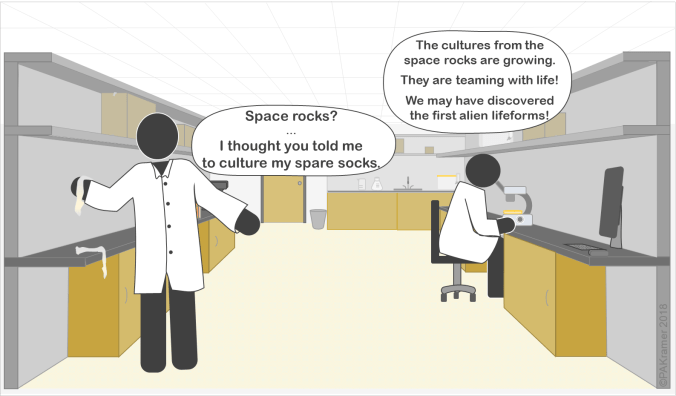
So you want to introduce a new lifeform in your fiction. There are many reasons to do so. A sentient humanoid can provoke your reader’s sympathy and relatability, while a vile, brainless, and flesh-eating slug can put your readers on edge. If done sloppily, however, skeptical readers will find the flaws in such a creature, and that disbelief will undermine any of your attempts to draw them into the story. You can blame biologists for always taking the fun out of your unique imagination, or you can choose to awe them with the many ways you manipulate biology into something terrifying or beautiful. After all, there are millions of weird and wonderful species on our own planet, some far more alien looking than what sci-fi authors have conjured up over the years.
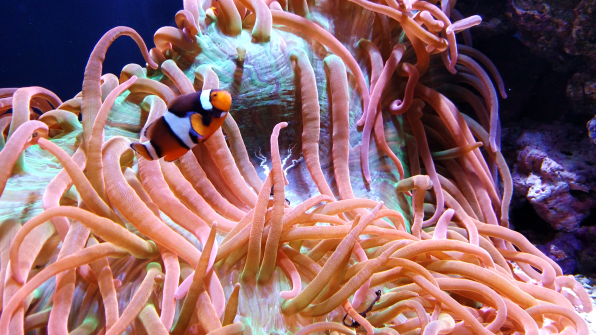
“Fish and anemone,” picture by Philip Kramer at the Seattle Aquarium
Here are the things you should consider when making a new species:
What is life anyway?
To breathe life into your creation, you should first understand what life is. The standard definition of life is an entity that can grow, reproduce, undergo metabolic processes, and sense and interact with the environment. This simplistic definition has led to some interesting debates. A virus for example, can do little to none of these things outside a host cell. Is it a living thing? Crystals too can take in energy and materials from their environment and use it to grow and reproduce. Is a crystal alive? Alien life will also likely defy some of these rules.
So what might life on another planet look like? This field of study is referred to as exobiology and astrobiology.
All life is a product of its environment.
Everything about life, down to each protein or strand of DNA, was selected for over the course of millions of years. If an organism died before passing on its genetic material, the next generation would not inherit those characteristics that lead to premature death. This is evolution, and because of it, nearly everything about you has a purpose and function.
True, there are some things that appear to have no function except to give scientists headaches. These things exist because they can, or because they did not provide an evolutionary disadvantage. For example, many of the glycoproteins coating each of our red blood cells have no apparent function. Others, like the Duffy antigen, are used by the malaria parasite to infect cells. As a result, many individuals whose ancestors were from malaria-prone regions do not express this antigen. The simple rule is this: evolution will select against adaptations that negatively affect a species’ chances of survival and procreation, but any adaptations that improve those chances, or don’t change them at all, will persist.
On Earth alone, evolution progressed down millions of branches depending on environmental pressures. Many of those branches ended when these evolutionary experiments failed or the creature was overpowered by another creature attempting to take over the same ecological niche. As humans, we adapted our opposable thumbs from grasping tree limbs to avoid predators on the ground and reach food high in the canopy. We became bipedal to facilitate running and giving us a height advantage to spot both predators and prey when traveling across the ground. When intelligence improved our ability to hunt and forage, we dedicated much more room and energy to developing it. For other animals, they took to the air, or stayed in the water, and evolved talons, teeth, and scales to defend themselves. Any change to the fictional environment would make your creatures change accordingly. If the atmosphere was just a little thicker, for example, like the one on Venus, instead of birds with wings, you might have puffer-fish like creatures that fill an air-bladder with hydrogen or oxygen to float around. If your creature lives in dark caves like Astyanax mexicanus, a Mexican cave fish, they will probably have no eyes, or at least not ones that function.
Familiar or strange?
Going out of your way to creating an entirely original and strange lifeform may not be necessary. In fact, some scientists think life can only come in a finite number of forms. So it is possible that alien lifeforms share characteristics with us or other life on our planet. Darwin’s Aliens, is a new theory suggesting that there are only a handful of ways biology can evolve to deal with its surroundings. Yes, even biology is beholden to the laws of physics. Take the eyes as an example; there are only a few ways a creature might focus light from its environment onto a cluster of light sensitive cells. Evidence suggests that eyes evolved independently on dozens of evolutionary branches on Earth into something that looks and operates very similarly. The number and placement of those eyes on the head are also no coincidence, allowing a large range of vision without taking up too much space and energy in the brain to process that information.
Just because alien life might look familiar, doesn’t mean it can’t be strange. You can still be creative with your alien. In fact, it is very unlikely aliens will look too similar or identical to life on Earth. Since we exist because of a series of random genetic mutations and environmental coincidences (like ice ages and the particular tilt of our planet caused by the moon), it is very unlikely a species from another planet will have experienced the same evolutionary history.
Designing your lifeform.
The simplest unit of life as we know it is the cell. Alien life will most likely be composed of cells too, as it is the natural progression of simple to complex life, and allows each unit to carry the genetic information required for it to grow and replicate. Your alien can be a single cell, or a complex lifeform composed of two or more of these units working together for mutual survival. This partnership also allows some cells to specialize in certain tasks (defense, digestion, locomotion, etc.) to make tissues and organ systems.
Here are some of the features and organ systems most complex life should have:
Size- No matter the planet, there will be gravity, so your lifeform’s proportions will likely adhere to the square-cube law. This law, while by no means strict, describes most of the complex terrestrial life on Earth. In simple terms, it describes the relationship between volume and surface area of a creature. As a creature grows in size, its surface area does not increase at the same rate as its volume. As a result, larger animals must have thicker limbs to support a greater mass, a circulatory system to deliver nutrients and gasses through its body, and methods to dissipate heat through its lower relative surface area. Increasing an insect to the size of a cow would make its exoskeleton heavy, and its spindly limbs unable to support the mass of its bulbous body. Additionally, it could no longer rely on it tracheoles and hemolymph to diffuse oxygen throughout its body.

“Pillbug,” by Philip Kramer, (edit of picture)
Skin- Often the largest organ in the body, it is the last barrier between living flesh and a harsh environment with no regard for living things. Making a sentient slime the primary host of a hot, water-poor planet like Venus would not only be impractical, but evolutionarily impossible. A type of lizard with scales that reflect infrared and are resistant to sulfuric acid rain, however, would be far more likely. If the planet is cold instead, fat deposits or thick fur will serve as good insulation.
In addition to a physical barrier, the skin can also serve as an optical defense or lure. Lizards, butterflies, encephalapods, and many other creatures disguise themselves with their surroundings, make themselves look menacing, or lure in other creatures by appearing to be harmless.
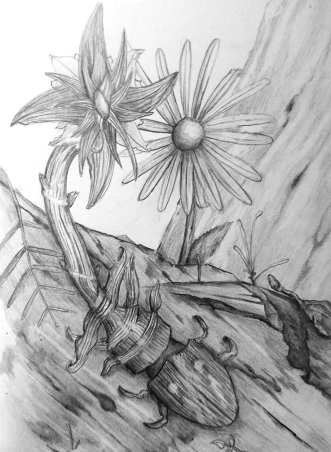
“The Fleatle,” by Ian Dowsett
Skeleton and muscles- In some cases, the skeleton can take place of the skin. This is known as an exoskeleton. While it can provide protection from the external world, it is not very deformable, and weighs too much on large creatures. Additionally, such a skeleton would limit growth, and occasional periods of molting would make the creature vulnerable to injury. An internal skeleton provides more joint versatility, structural support, and anchorage for ligaments and tendons. Add muscles, and the creature will be able to move through and manipulate the environment around them. The means of locomotion will vary depending on its evolutionary environment, allowing for wings, fins, tentacles, or feet and hands. The type and position of joints is going to alter the function of the limb. For example, the elbow and knee are terribly weak joints (the fulcrum near the end of lever), meaning it takes a large amount of force to move the limb. Why would evolution do this? While the arms and legs are weak, their length away from the pivot point means they can move at incredible speeds, ideal for running, climbing, and throwing things. By contrast, relatively small muscles in joints used for crushing and raw strength, like the jaw, can allow bite pressures of over a thousand pounds per square inch in the hippopotamus, alligator, and hyena.

“Gra’Sugra” conceptualized by Tim Kramer, illustrated by Joseph Martin
Brain- The nervous system, a means by which creatures control their limbs and the movement and function of other organs, can be simple or complex. For complex creatures, they come in two major types: centralized and decentralized. A central nervous system, like our brain and spinal cord, control all peripheral communications. A decentralized nervous system, like the octopus, has multiple little brains that can act independently of one another, or coordinate with each other without sacrificing intelligence. If your human explores encounter an alien starship, chances are the alien creature will have a complex nervous system, for how else would they have constructed such advanced technology.
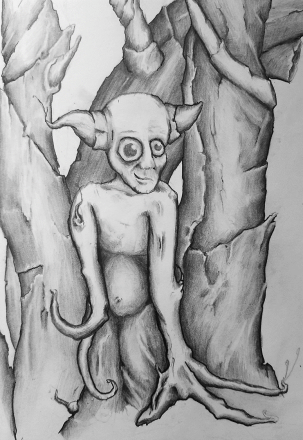
Centralized nervous system- “ForC” by Ian Dowsett

Decentralized nervous system-“Drude” by Ian Dowsett
Metabolism and digestion- Biology is a huge source of entropy, bringing far more chaos into the universe than order. Life gets its energy by breaking existing molecular bonds and using that energy to create new ones. But we break far more bonds than we form. As humans, we must consume dozens of tons of food over the course of our lifetimes just to maintain our relatively unchanged size and shape, and perform comparatively low-energy functions.
The source of molecular energy a lifeform uses can vary. On Earth, most life gets its energy from breaking down simple carbohydrates, fats, or proteins. These in turn were formed by other lifeforms. Chances are the circle of life will come back to plants, who ultimately get their energy from the sun to form carbohydrates. In areas that lack sunlight or are too inhospitable for plant life, ecosystems revolve around other root sources of energy. Deep under the ocean at hydrothermal vents, where temperatures can reach higher than 400 degrees Celsius, the base life form are extremophiles (Archaea) which can use non-organic compounds to synthesize energy in the absence of sunlight. These in turn feed larger crustaceans and nematodes.
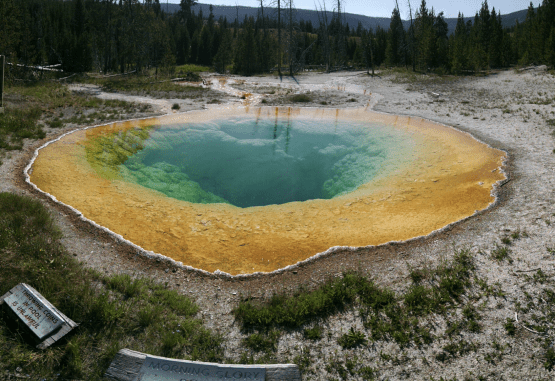
Morning glory pool at Yellowstone. Many colors attributed to extremophiles. Picture by Philip Kramer
It is also possible, that aliens will not find humanity or other forms of life appetizing unless they evolved similarly. We have very specialized enzymes for very specific foods, like glucose (D-glucose, not L-glucose), amino acids (L, not D), and fats. If an alien predator does not utilize these same substrates, we will not taste very good or sit very well with them.
Waste disposal- On that topic, waste disposal is another must for complex organisms. It is impossible to digest, utilize, and recycle 100% of ingested food. At some point, toxins, and metabolic waste will need to be eliminated. Intestine type organs to digest and absorb, a liver to detoxify, and a kidney to filter our liquid waste, are common features of most complex life on Earth. Some creatures, like birds, reptiles, and most fish release both solid and liquid waste and reproduce through a single orifice called the cloaca. The aliens in The Post-Apocalyptic Tourist’s Guide series, have such an orifice, much to the amusement of all the authors in the series.

Alien from The Post-Apocalyptic Tourist’s Guide series, illustrated by Stephen Lawson. Note: over-emphasized cloaca.
Reproduction- Life is complex, therefore it requires a lot of genetic information to maintain and recreate it. No matter what your alien species, they will have a genetic material (could be DNA, or some silicon-based version of it), and a method of reproduction. It can be an asexual species that creates clone-like copies of themselves like many starfish, or it can reproduce like humans and most other animals with two or more members of the species contributing genetic code.
 “Starfish,” by Philip Kramer, (edit of picture)
“Starfish,” by Philip Kramer, (edit of picture)
Or, like slugs, they can be hermaphroditic, possessing both male and female reproductive organs.

“Seattle slug,” by Philip Kramer (edit of picture)
Circulation and respiration- The need for a way to distribute metabolic substrates and facilitate gaseous exchange is necessary for all large and complex organisms, including plants. The lungs and/or gills would need high surface area to facilitate the transfer of gasses. In smaller creatures, diffusion is sufficient, though rudimentary tracheoles, a heart, and hemolymph are present in many insects. Aside from supporting metabolism, the circulation is an ideal medium to support an internal defense against invading organisms. Most animals have a complex immune system supporting many types of specialized cells. Any alien coming to Earth would not have the adaptive or innate immunity required to repel local microorganisms. We would also have no defense against alien microbes.
Senses- Like locomotion, the senses will be defined by the environmental medium and ecological niche of the creature. Vibrations travel through air far better and faster than they do through a medium with little to no compressibility like stone or water, so many terrestrial creatures will likely have ears. Assuming there is light to see by, aliens will also have a type of eye, though it may see different parts of the spectrum. Tiny hairs, like those on insects, could improve tactile awareness, and receptors for aromatic molecules can provide a sense of smell. Humans have far more than five senses, so there are plenty to choose from to make your aliens as aware or unaware of their surroundings as you want. If, for example, your aliens only see in infrared, your space troops could use a special armor to disguise their heat signature.
 “Samuel,” by Ian Dowsett
“Samuel,” by Ian Dowsett
Mechanical augmentations- Aliens with a computer driven intelligence or mechanical augmentations are an exception to many of these “rules.” They will need energy, but this can come in many different forms, and they will not need to digest or dispose of waste in the same way. Despite the differences, however, they would have needed an intelligent biological host or a biological predecessor to design them. Seeing as how mechanical lifeforms are far more resilient, they will likely be the first interstellar visitors we encounter.
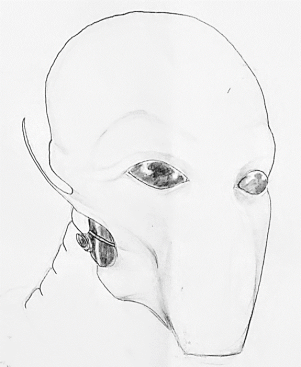
“The Tide,” Conceptualized by Tim Kramer, illustrated by Joseph Martin
Conclusion.
Congratulations, you have now made an imaginary lifeform and, ipso facto, you now have imaginary godhood. Don’t let it go to your head. Even a novice biologist will likely be able to undo all your hard work. But you have one thing going for you. Give your creatures all the things required of life, make it beholden to the laws of physics, and a product of its environment, and even those pesky naysayers won’t be able to prove its nonexistence. If you are still having trouble, take a page out our own planet’s ecological history. There are many millions of species with unique features, functions, and evolutionary trees, right here on Earth. With a little bit of research and imagination, we can all be amateur exobiologists.
Until next time, write well and science hard.
 So this was a first. A couple weeks ago I was interviewed by my alma mater, Auburn University Montgomery, for their article series titled “#WhyWeLearn.”
So this was a first. A couple weeks ago I was interviewed by my alma mater, Auburn University Montgomery, for their article series titled “#WhyWeLearn.”